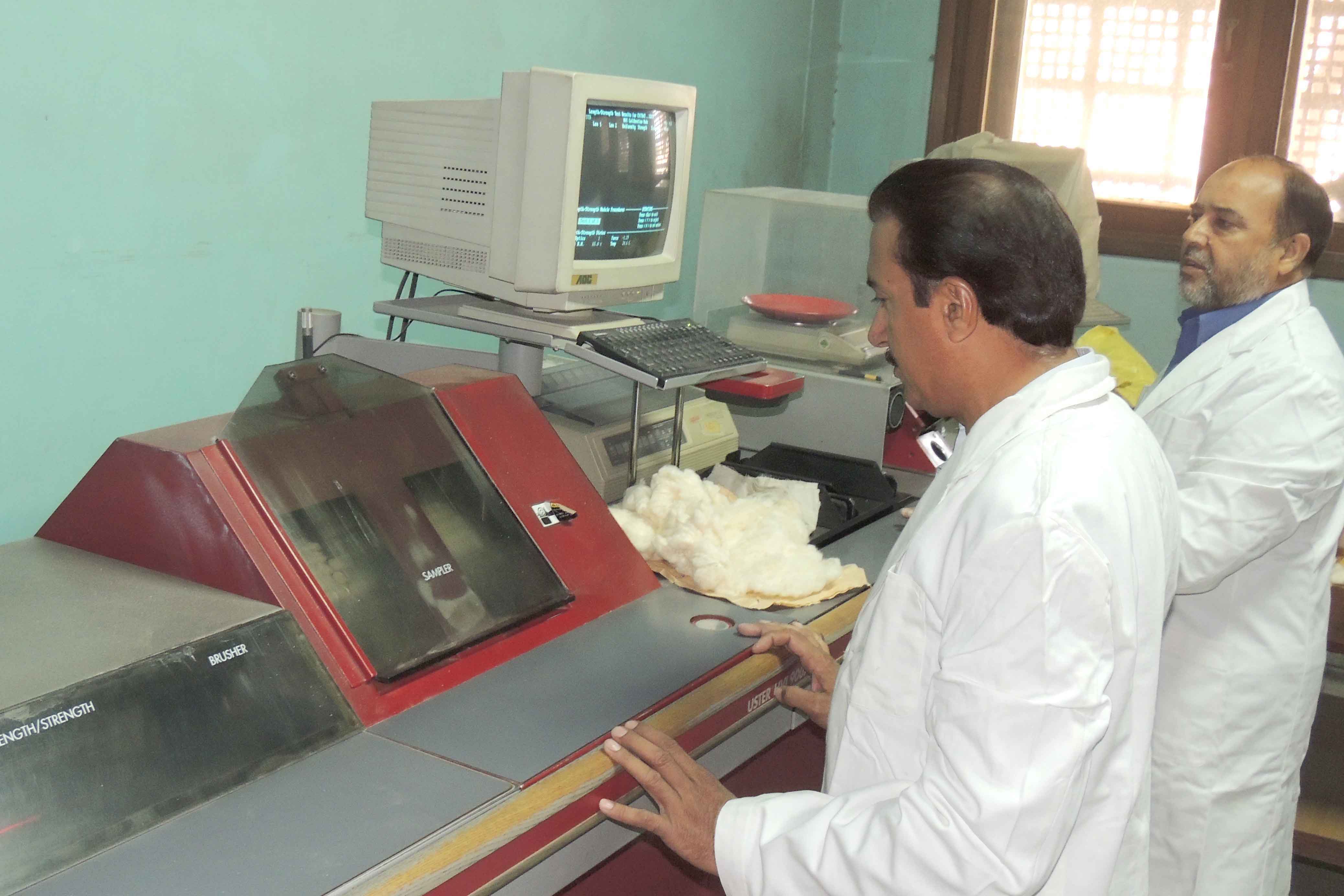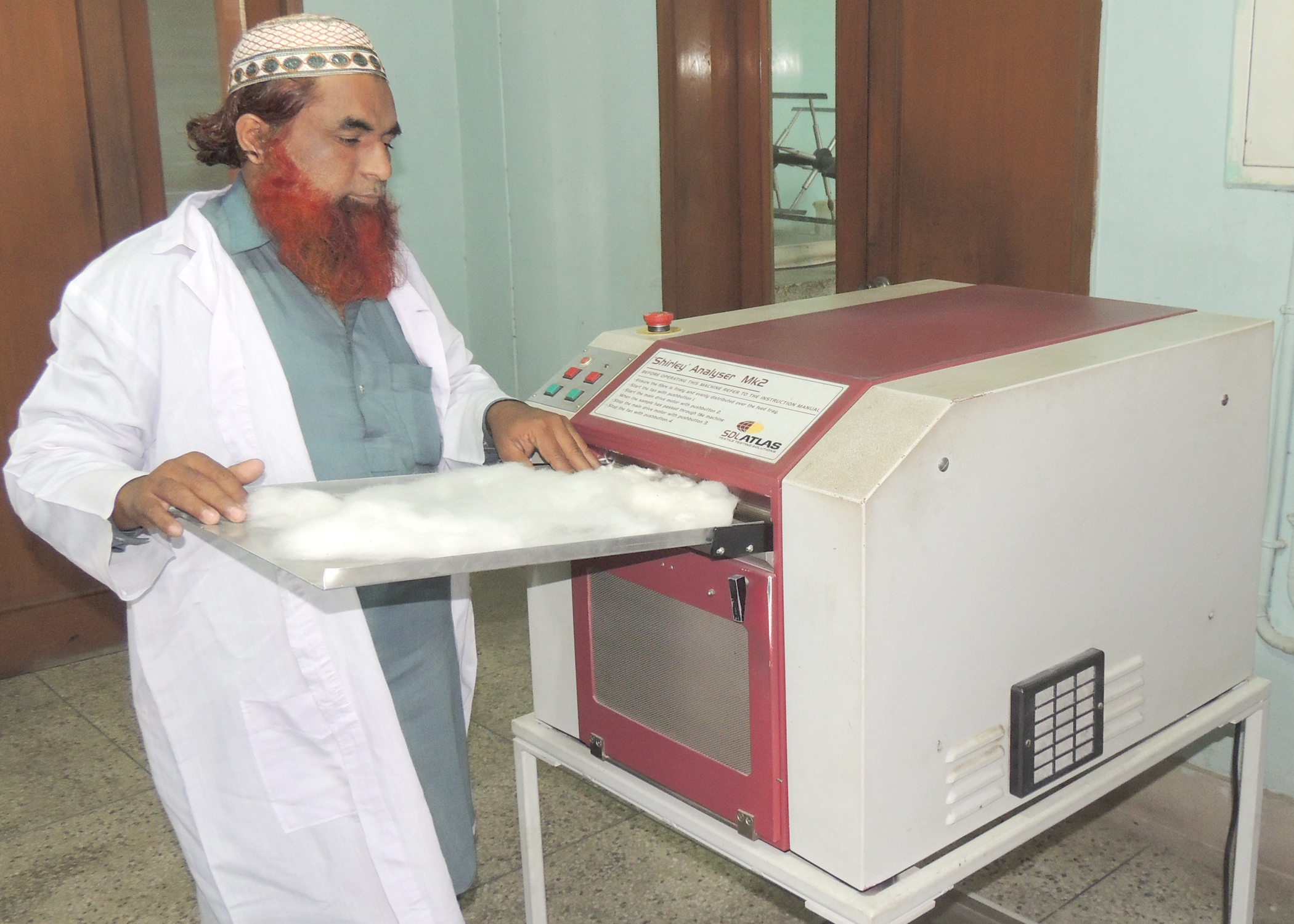

Fibre Technology section was established in 1976. The prime objective of Fibre Technology section is to provide technical support to Plant Breeding & Cytogenetics sections in testing of fibre characteristics and spinning potential of newly developed cotton cultivars & strains and facilitates the other sections of the institute as well, to investigate the effect of different agricultural practices on fibre characteristics. The section is extending services to other cotton research stations of PCCC, Government & private cotton agencies, commercial organizations, textile industry, progressive growers and providing research facilities and technical support to the research scholars from various textile institutes and universities in fibre testing and spinning of their research material. Apart from lab work, the section is also contributes in collaborative research studies with different sections of the institute.
Fibre technology section is equipped with sophisticated and scientific fibre testing instruments and micro-spinning facility.
High Volume Instrument, the standard cotton measurement instrument with the highest degree of accuracy and precision used in major cotton research operations around the world. Standard measurements of fibre length, uniformity, strength, micronaire, color, trash, fibre elongation, short fibre index, cotton maturity and  sample moisture content for evaluating a specific cotton type. All these properties are very important in cotton research for developing new strain. Approx. 30 grams sample of lint is required for complete testing on HVI. The main two modules of HVI are given below:
sample moisture content for evaluating a specific cotton type. All these properties are very important in cotton research for developing new strain. Approx. 30 grams sample of lint is required for complete testing on HVI. The main two modules of HVI are given below:
The Length/Strength Module measures two samples simultaneously; place approximately 8 to 10 grams of fibre in each of the sample buckets; it automatic prepares the comb from the material in each of the buckets. The combs slide along the comb track until the first one is positioned in front of the brusher. As soon as the comb is in place, the brusher automatically removes loose fibre from the beard while simultaneously cleaning and aligning the remaining fibres. It is then moved along the comb track to the lens and jaw system where the fibre beard is scanned from base to tip for measuring length, uniformity and short fibre index. Length uniformity is the ratio between the mean length and upper half mean length of the fibres and is expressed as a percentage. Strength and elongation are measured based on breaking the tapered beards using 3.2 mm (1/8 inch) clamp spacing.Micronaire is measure of fibre fineness and maturity. An airflow instrument is used to measure the air permeability of a weigh between 8.5 to 11.5 grams of cotton fibres compressed to a fixed volume.
Low volume Instrument measures length, length uniformity and short fibre index. The LVI works on the principle of photo electricity. The test specimen is scanned by highly sensitive and stable optical system. Through a lens arrangement, light is focused in one side of the beard. A narrow beam of light from a light source passed through the beard and into the photoelectric tube. The absorption of light by the beard is measure of number of fibres contained at the point where the light beam passes through sample. Advanced Fibre Information System is used for measuring neps, length, diameter and trash of single fibre and provides data and distributions of the measured properties. The process of separating a sample into single fibre of this apparatus is similar to processing conditions encountered in modern textile machinery.The Pressley Fibre Strength Tester used in cotton breeding, marketing and spinning, measuring the tensile strength of fibres. The Pressley tests a flat bundle of parallel fibres clamped between a set of jaws at a zero gauge length or a 3.2 mm length. The mass of the broken bundle is measured to determine fibre tenacity.
 The Stelometer simultaneously measures strength (tenacity) and elongation of fibres. The Stelometer uses the Pressley jaws and a pendulum principle to apply a constant rate of loading on the cotton fibre being held at 3.2 mm gauge lengthMicromat Tester measures maturity, fineness and micronaire of cotton. This instrument has a double compression airflow device that measures the pressure drop of air drawn through a 4 gram of compressed sample.Fibre Blender is used for cleaning and randomizing cotton samples for further processing.Shirley Trash Analyzer determines lint, trash and dust content within a sample of cotton fibre. The analyzer uses the carding principle with air separation of lint and non-lint content
The Stelometer simultaneously measures strength (tenacity) and elongation of fibres. The Stelometer uses the Pressley jaws and a pendulum principle to apply a constant rate of loading on the cotton fibre being held at 3.2 mm gauge lengthMicromat Tester measures maturity, fineness and micronaire of cotton. This instrument has a double compression airflow device that measures the pressure drop of air drawn through a 4 gram of compressed sample.Fibre Blender is used for cleaning and randomizing cotton samples for further processing.Shirley Trash Analyzer determines lint, trash and dust content within a sample of cotton fibre. The analyzer uses the carding principle with air separation of lint and non-lint content